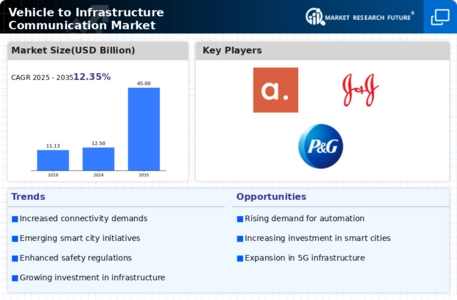Government Initiatives and Funding
Government initiatives aimed at enhancing transportation infrastructure are significantly influencing the Vehicle to Infrastructure Communication Market. Various governments are investing in smart infrastructure projects that incorporate advanced communication technologies. For instance, funding programs for smart traffic signals and connected roadways are becoming increasingly common. In 2023, it was reported that government spending on smart infrastructure reached approximately 200 billion, indicating a robust commitment to modernizing transportation systems. Such investments not only improve road safety but also promote the adoption of Vehicle to Infrastructure Communication technologies, thereby driving market growth.
Integration with Autonomous Vehicles
The integration of autonomous vehicles into the transportation ecosystem is a pivotal driver for the Vehicle to Infrastructure Communication Market. As the number of autonomous vehicles increases, the need for seamless communication between these vehicles and infrastructure becomes paramount. This integration facilitates real-time data exchange, enhancing traffic management and safety. According to recent estimates, the autonomous vehicle market is projected to reach a valuation of over 500 billion by 2030, which underscores the potential growth of the Vehicle to Infrastructure Communication Market. The synergy between autonomous vehicles and infrastructure communication systems could lead to more efficient urban mobility solutions, thereby transforming transportation dynamics.
Rising Demand for Traffic Management Solutions
The escalating demand for efficient traffic management solutions is a crucial driver for the Vehicle to Infrastructure Communication Market. As urban populations grow, cities face increasing congestion challenges. Vehicle to Infrastructure Communication technologies offer innovative solutions to alleviate traffic congestion through real-time data sharing and predictive analytics. In 2024, the traffic management systems market was valued at around 30 billion, reflecting a growing recognition of the need for advanced traffic solutions. By enabling vehicles to communicate with traffic signals and other infrastructure, these technologies can optimize traffic flow, reduce travel times, and enhance overall urban mobility.
Increased Focus on Environmental Sustainability
The heightened emphasis on environmental sustainability is shaping the Vehicle to Infrastructure Communication Market. As cities strive to reduce carbon emissions and promote eco-friendly transportation, Vehicle to Infrastructure Communication technologies play a vital role. These systems can facilitate the integration of electric vehicles and optimize traffic patterns to minimize fuel consumption. In 2025, it is anticipated that the market for electric vehicles will surpass 1 trillion, further driving the need for effective communication with infrastructure. By supporting sustainable transportation initiatives, the Vehicle to Infrastructure Communication Market is positioned to contribute significantly to environmental goals.
Technological Advancements in Communication Systems
Technological advancements in communication systems are propelling the Vehicle to Infrastructure Communication Market forward. Innovations such as 5G technology and edge computing are enhancing the capabilities of communication networks, enabling faster and more reliable data exchange between vehicles and infrastructure. The deployment of 5G networks is expected to reach 1 billion connections by 2025, which will significantly enhance the performance of Vehicle to Infrastructure Communication systems. These advancements not only improve safety and efficiency but also pave the way for new applications in smart transportation, thereby expanding the market's potential.














Leave a Comment